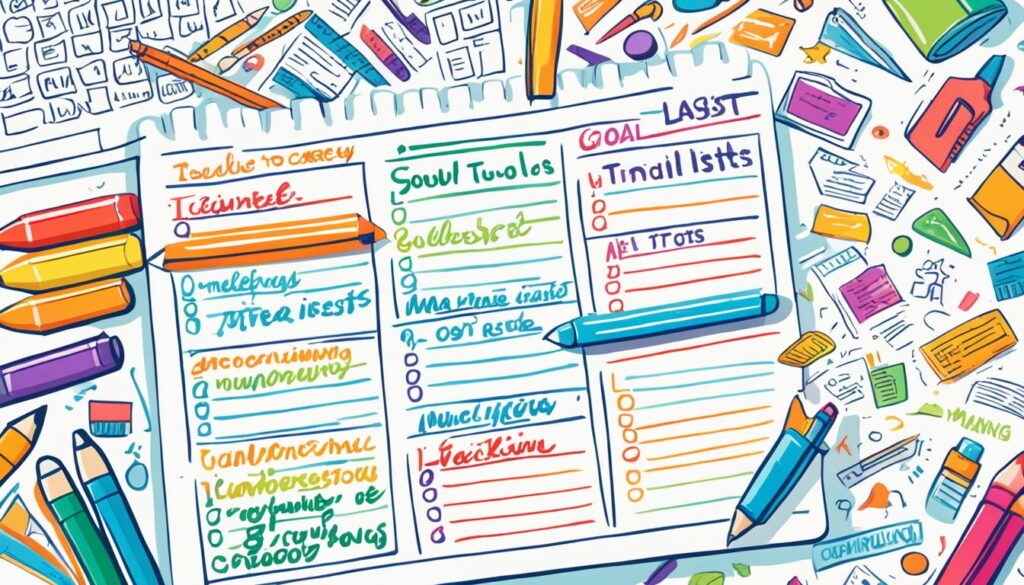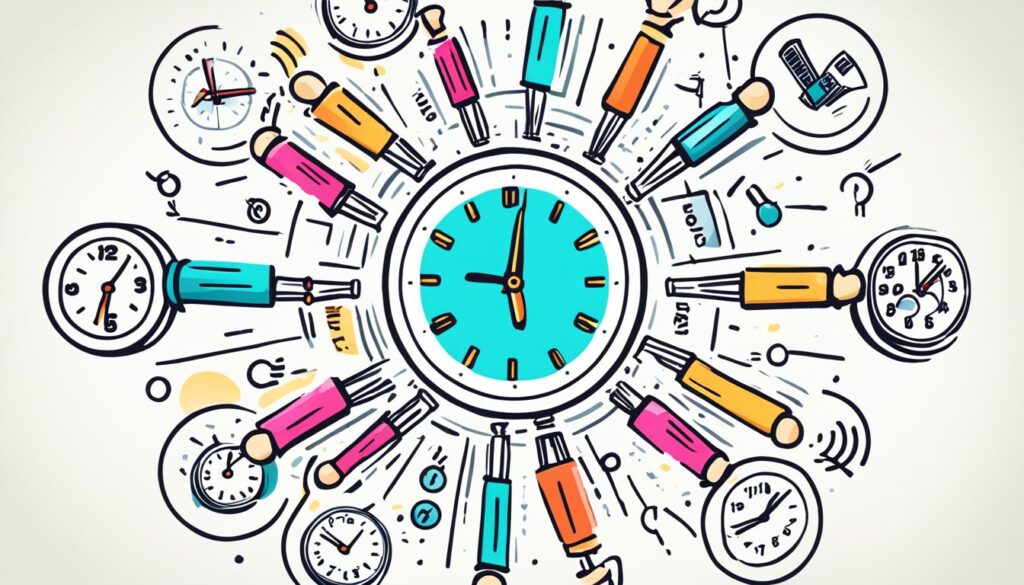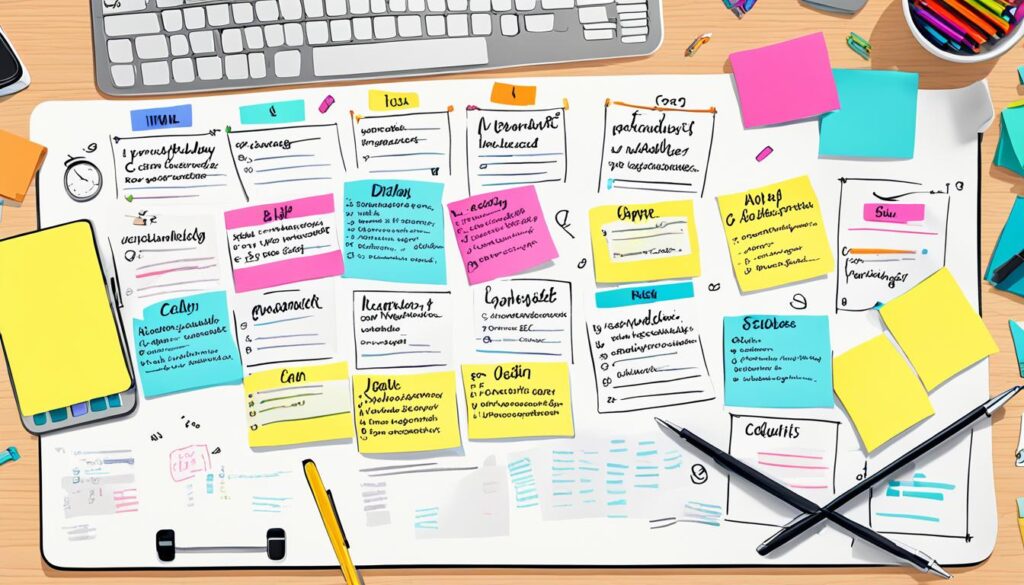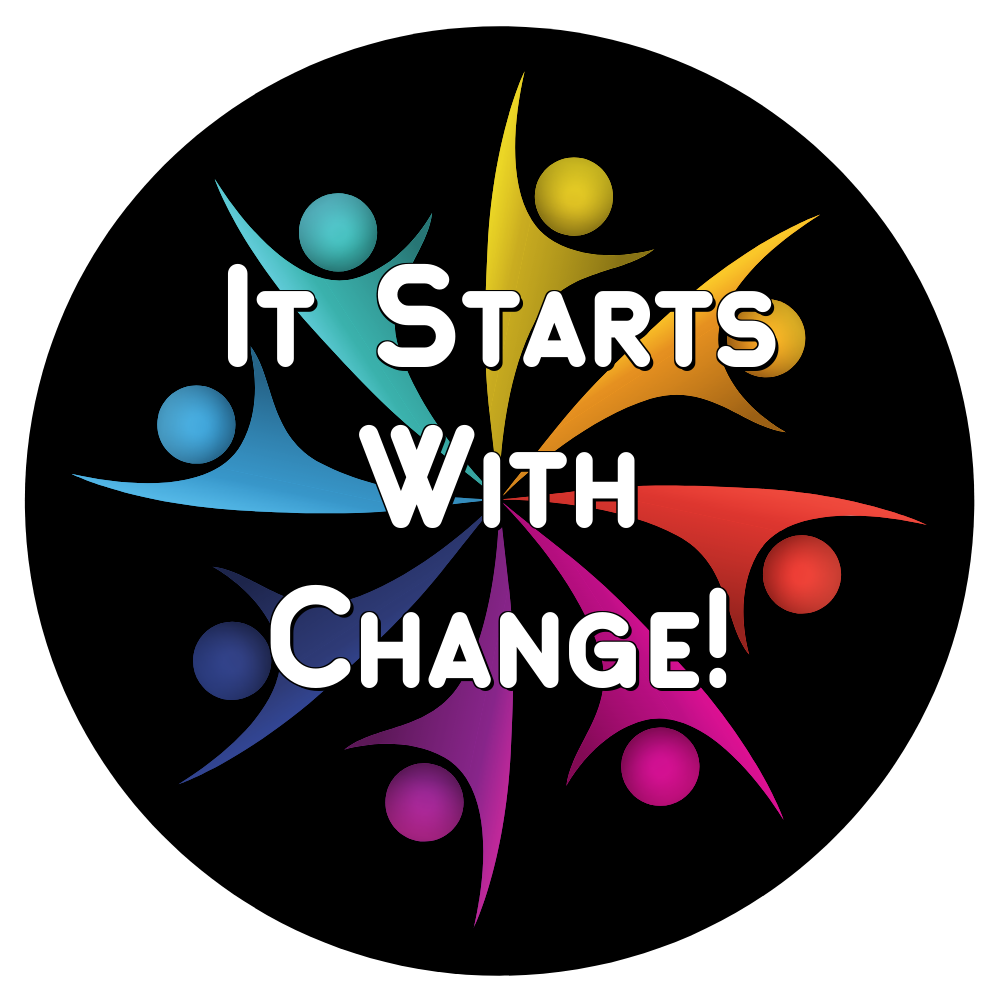Did you know that the average person spends 2.5 days each year looking for misplaced items? That’s a staggering amount of time wasted on disorganization and clutter. But fear not, because there are plenty of life organization hacks that can help you reclaim control over your time and productivity. By implementing simple strategies like decluttering, making lists, setting up routines, automating tasks, creating to-do lists, learning to say “no,” and delegating, you can transform your daily routine into a well-oiled machine.
Key Takeaways:
- Simplifying your possessions and decluttering can create a more organized and stress-free environment.
- Making lists for everything helps prioritize tasks and prevent important items from being forgotten.
- Establishing routines can significantly improve productivity and simplify your schedule.
- Automating tasks saves time and mental energy, allowing you to focus on more important activities.
- Creating to-do lists helps prioritize tasks and keeps you organized throughout the day.
Simplify Your Possessions
When it comes to streamlining your life, the first step is to simplify your possessions. Physical clutter can lead to mental clutter, making it harder to stay organized and focused. By decluttering and getting rid of unnecessary items, you can create a more serene and productive living environment.
Marie Kondo’s KonMari method, a popular decluttering technique, emphasizes keeping only items that spark joy. This approach can help you determine which possessions are truly valuable to you and let go of the rest.
Utilizing organization tools can also play a significant role in simplifying your possessions. Storage bins, closet organizers, and other organization tools can help you maximize space and keep items neatly arranged.
Take a look at how these organization tools can help simplify your possessions:
| Organization Tool | Benefits |
|---|---|
| Storage Bins | – Keep items categorized and easily accessible – Reduce visual clutter – Maximize storage space |
| Closet Organizers | – Optimize closet space – Arrange clothes, shoes, and accessories efficiently – Streamline getting dressed |
| Shelving Units | – Display items in an organized and aesthetically pleasing way – Create additional storage space – Keep frequently used items within reach |
By simplifying your possessions and utilizing decluttering techniques along with organization tools, you can create a more organized and peaceful living space. This will not only make it easier to find what you need but also enhance your overall well-being and productivity.
Make Lists for Everything
Making lists for everything can be a game-changer when it comes to streamlining your day. By creating lists, you can stay organized, prioritize tasks, and ensure that nothing slips through the cracks. Whether it’s a simple to-do list, a grocery list, or a list of goals, this productivity tip can help you stay on top of your game.
One of the easiest ways to make lists is by keeping a notepad or list on hand. Whenever a task or idea pops into your head, jot it down immediately. This prevents you from forgetting important items and saves you time trying to remember them later. Plus, there’s something satisfying about crossing items off a physical list!
“The best way to get things done is to simply make a list.” – John Doe
For those who prefer digital options, there are plenty of organization tools available. Digital to-do lists and reminder apps can help you keep track of your lists and stay organized on the go. With features like notifications and synchronization across devices, you’ll never miss a task again.
Benefits of Making Lists:
- Clear visualization of tasks and goals
- Improved focus and productivity
- Reduced mental clutter and stress
- Ability to prioritize and delegate tasks
When you make lists, you have a visual representation of what needs to be done. This clarity allows you to focus on one task at a time, leading to increased productivity. It also helps reduce mental clutter and stress, as you no longer have to rely on your memory to remember everything.
If you find that your list is overwhelming, take a step back and prioritize. Focus on the most important and urgent tasks first, and consider delegating or postponing less critical ones. By breaking down your list into manageable chunks, you’ll feel more in control and accomplish more.

So whether you prefer the pen-and-paper approach or embrace the digital era, start making lists for everything. Take advantage of organization tools and productivity tips to streamline your day and make your life more efficient.
Set Up Routines
Setting up routines in your daily life can be a game-changer when it comes to productivity and time management. By establishing consistent habits and schedules, you can streamline your day, reduce decision fatigue, and accomplish tasks more efficiently.
Start by identifying areas of your life that could benefit from a routine. It could be your morning routine, cleaning routine, or even a workout routine. Focus on one routine at a time and gradually incorporate more into your life as you become comfortable.
Having a morning routine, for example, can set the tone for the rest of the day. It helps you start your day on a positive note and ensures that you tackle important tasks right from the get-go. Consider incorporating activities like meditation, exercise, or planning your day into your morning routine.

One of the key benefits of routines is that they help minimize decision-making. When you have a set routine, you don’t waste time and mental energy figuring out what to do next. Instead, you already have a plan in place, allowing you to focus your time and attention on completing tasks.
Establishing routines also creates consistency and helps your brain develop automatic behavior. By doing activities in a certain order consistently, you train your brain to associate those actions with specific times and triggers. This leads to increased efficiency and saves valuable time throughout the day.
“Routines are the backbone of daily success.” – Charles Duhigg
When setting up routines, remember to be flexible and adjust them as needed. Life is ever-changing, and it’s okay to modify your routines to fit new circumstances. The goal is to create structure and simplify your life, not to feel constricted by rigid schedules.
Tips to Set Up Effective Routines
- Identify areas of your life that could benefit from a routine.
- Start with one routine at a time to avoid feeling overwhelmed.
- Create a schedule that works for you and takes into account your unique circumstances.
- Write down your routines and keep them visible to serve as a constant reminder.
- Be consistent and stick to your routines as much as possible.
- Periodically evaluate and adjust your routines to ensure they are still serving you well.
By setting up routines, you can create a sense of structure and stability in your life. This, in turn, leads to increased productivity, better time management, and a more balanced lifestyle. Start small, be consistent, and enjoy the benefits of streamlined routines in your daily routine.
Automate Tasks
Automating tasks is a game-changer when it comes to boosting productivity and saving time. By automating routine and repetitive tasks, you can free up valuable mental energy to focus on more important activities. Here are some productivity tips and time management strategies to help you automate tasks effectively:
Scheduling Automatic Bill Payments
One of the easiest ways to automate tasks is by setting up automatic bill payments. By doing so, you can avoid late fees and ensure your finances are managed efficiently. Simply connect your bank account or credit card to the service provider, authorize automatic payments, and rest assured that your bills will be paid on time without manual intervention.
Email Responses Made Easy
Responding to numerous emails can be a time-consuming task. With automation tools, you can streamline your email communication and save precious minutes each day. Take advantage of features like email templates and canned responses to quickly reply to common inquiries or requests. This not only saves time but also ensures consistency in your responses.
“Automating tasks frees up valuable mental energy to focus on more important activities.”
Social Media Scheduling
Managing social media accounts can be a significant drain on your time. But with the help of automation tools, you can schedule posts in advance, ensuring a consistent presence without constant manual effort. Use social media management platforms that allow you to create content calendars, plan your posts, and automatically publish them at the desired times.
Now, let’s take a look at how automation can impact your daily routine:
| Manual Task | Automated Solution |
|---|---|
| Manually paying bills every month | Scheduling automatic bill payments |
| Spending time crafting individual email responses | Using email automation tools for canned responses |
| Manually monitoring and posting on social media | Using social media scheduling tools |
By automating these tasks, you can save valuable time and redirect your focus towards activities that require your unique skills and attention. Embrace automation to unlock your productivity potential and achieve more in less time.
Create To-Do Lists
One of the most effective productivity tips is to create to-do lists. By organizing your tasks in a systematic manner, you can prioritize effectively and stay on top of your responsibilities. Whether it’s for work, school, or personal errands, a to-do list helps ensure that nothing falls through the cracks.
To make the most of your to-do list, start by making it the night before for the next day. This allows you to start each day with a clear sense of what needs to be done and helps you avoid feeling overwhelmed. Consider using digital planners or task management apps to create, update, and manage your to-do lists efficiently.
Benefits of Using To-Do Lists
- Priority management: To-do lists help you identify the top three priority tasks for the day. By focusing on these key tasks, you can make significant progress and feel accomplished.
- Organization: By listing out your tasks, you can visualize your workload and allocate time accordingly. This ensures that you allocate the necessary time and attention to each task.
- Mental clarity: A clear and concise to-do list helps reduce mental clutter and allows you to approach your tasks with a focused mindset.
When creating your to-do list, start by writing down all the tasks that need to be completed. Then, prioritize them based on urgency, importance, or deadlines. Once you have prioritized your tasks, tackle the most challenging one first. This way, you’ll have the most energy and motivation to overcome any obstacles.
Remember to be realistic with your to-do list. Avoid overwhelming yourself by setting unrealistic expectations. Break down larger tasks into smaller, manageable steps to make progress more achievable.
Here is an example of how a to-do list might look:
| Task | Priority |
|---|---|
| Submit report | High |
| Attend meeting | Medium |
| Buy groceries | Low |
| Exercise | Low |
By following these tips and utilizing organization tools such as digital planners or task management apps, you can create effective to-do lists that boost your productivity and keep you on track.

Learn to Say “No”
Learning to say “no” is an essential skill for streamlining your life and maximizing your productivity. It’s important to prioritize activities that align with your goals and values, and to have the courage to decline requests that don’t align with your priorities.
By saying “no” to tasks, commitments, or obligations that don’t serve your best interests, you can free up valuable time and energy to focus on what truly matters to you. This act of prioritization allows you to allocate your resources effectively and devote your attention to activities that bring you fulfillment and move you closer to your goals.
Saying “no” doesn’t mean being selfish or insensitive to others’ needs. It’s about setting boundaries and making deliberate choices about how you spend your time and energy. Learning to say “no” with grace and kindness can help you maintain healthy relationships and protect your own well-being.
Here are a few tips to help you learn to say “no” effectively:
- Know your priorities: Take the time to identify your core values, goals, and priorities. When you have a clear understanding of what truly matters to you, it becomes easier to say “no” to activities that don’t align with those priorities.
- Practice assertiveness: Communicate your boundaries politely but firmly. Use “I” statements to express your needs and offer alternatives when possible.
- Be selective: Evaluate each request or opportunity based on its alignment with your goals and values. Prioritize activities that have the greatest potential for personal or professional growth.
- Set realistic expectations: Be honest about what you can and cannot do. Avoid overcommitting yourself and spreading yourself too thin.
- Delegate when possible: If saying “no” outright isn’t an option, consider delegating tasks or responsibilities to others who may be better suited or have more time available.
Remember, learning to say “no” is not a one-time event but an ongoing practice. As you become more comfortable setting boundaries and prioritizing your time, you’ll find that your productivity and overall well-being improve.
“The difference between successful people and very successful people is that very successful people say ‘no’ to almost everything.” – Warren Buffett
So don’t be afraid to say “no” when it’s necessary. It’s a powerful tool for taking control of your time, staying focused on your priorities, and achieving the success you desire.
Benefits of Learning to Say “No”
| Benefits | Explanation |
|---|---|
| Improved Time Management | By saying “no” to non-essential tasks, you can allocate your time more effectively and focus on activities that are truly important to you. |
| Reduced Stress | Clearing your schedule of unnecessary commitments can help reduce overwhelm and stress, allowing you to maintain a healthier work-life balance. |
| Increased Productivity | When you say “no” to distractions and unrelated tasks, you can channel your energy toward high-priority projects and tasks, leading to increased productivity. |
| Enhanced Well-being | Learning to say “no” enables you to protect your physical and mental health by avoiding excessive workloads and unnecessary stress. |
Conclusion
By implementing these life organization hacks and productivity tips, you can streamline your routines and take control of your daily life. Simplifying your possessions through decluttering techniques and utilizing organization tools can create an organized space that brings you peace of mind. Making lists for everything and setting up routines allow you to prioritize tasks and accomplish them efficiently.
Automating tasks and creating to-do lists help save time and mental energy, enabling you to focus on more important activities. Learning to say “no” and delegating tasks that don’t align with your priorities empower you to make time for what truly matters to you. By embracing these strategies, you can declutter your routine, maximize productivity, and live your best life.
Start implementing these life organization hacks today and experience the transformative effects they can have on your daily efficiency and overall well-being. Streamline your life, unlock your full potential, and create a smoother and more efficient daily routine.






